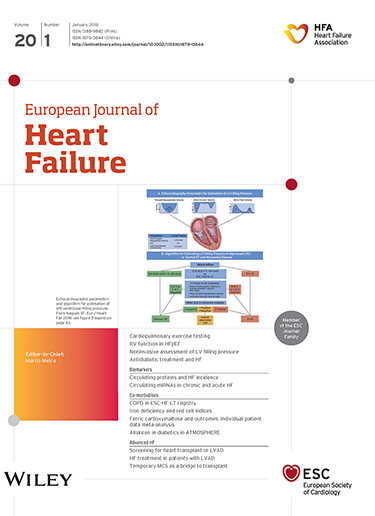Contemporary implementation of guideline-directed medical and device therapies in heart failure: Insights from the Central/Eastern Europe Quality of Care Centres Survey.
IF 10.8
1区 医学
Q1 CARDIAC & CARDIOVASCULAR SYSTEMS
引用次数: 0
Abstract
AIMS The Central/Eastern Europe (CEE) Quality of Care Centres (QCC) Survey evaluated the implementation of guideline-directed medical therapies (GDMT) and device use at discharge after heart failure (HF) hospitalization in CEE, where GDMT underutilization remains a concern. METHODS AND RESULTS Between March 2024 and January 2025, 2251 patients (mean age 70.0 years, 60.4% male) were enrolled at discharge from 21 centres across 12 CEE countries. The patient population included HF with reduced ejection fraction (HFrEF) (55.5%), HF with mildly reduced ejection fraction (15.3%) and HF with preserved ejection fraction (27.9%). In the total population, from admission to discharge there was a increase in the use of angiotensin receptor-neprilysin inhibitor (ARNI) (17.1% to 34.3%), beta-blockers (69.4% to 92.4%), mineralocorticoid receptor antagonists (MRA) (44.0% to 82.1%) and sodium-glucose co-transporter 2 inhibitors (SGLT2i) (30.8% to 79.9%), with a reduction in angiotensin-converting enzyme inhibitor (ACEI) use (all p < 0.05). Similar trends were observed across HF phenotypes, including HFrEF (increased use of ARNI, 26.3% to 55.1%, beta-blockers, 69.8% to 95.3%, MRA 49.5% to 89.0%, and SGLT2I 36.2% to 79.8%, and lower ACEI use, all p < 0.05). At discharge, 53.5% of patients received quadruple therapy (63.9% with HFrEF), while ≥50% target doses of titratable drugs were achieved in 18.8% (17.8% in HFrEF). Predictors of GDMT underuse included older age, lower education, living alone, non-ischaemic HF, higher ejection fraction, chronic kidney disease, hypotension, hyperkalaemia, prolonged hospitalization, and residual oedema. Among eligible HFrEF patients, 21.3% were discharged with, or referred for implantable cardioverter-defibrillator, and 17.4% for cardiac resynchronization therapy. CONCLUSIONS The CEE-QCC Survey highlights substantial in-hospital GDMT implementation and up-titration, though device use remains limited. Targeted strategies are needed to enhance guideline implementation and ensure optimal HF care across the CEE region.心脏衰竭指导医疗和器械治疗的当代实施:来自中欧/东欧护理中心质量调查的见解。
目的:中欧/东欧(CEE)护理中心质量(QCC)调查评估了指南导向医疗治疗(GDMT)的实施情况和中东欧心力衰竭(HF)住院后出院时设备的使用情况,其中GDMT利用不足仍然是一个问题。方法和结果在2024年3月至2025年1月期间,来自12个中东欧国家21个中心的2251名患者(平均年龄70.0岁,60.4%为男性)被纳入出院组。患者人群包括射血分数降低的HF(55.5%),轻度射血分数降低的HF(15.3%)和保留射血分数的HF(27.9%)。在总体人群中,从入院到出院,血管紧张素受体-neprilysin抑制剂(ARNI)的使用增加(17.1%至34.3%),β受体阻滞剂(69.4%至92.4%),矿皮质激素受体拮抗剂(MRA)(44.0%至82.1%)和钠-葡萄糖共转运蛋白2抑制剂(sgltti)(30.8%至79.9%),血管紧张素转换酶抑制剂(ACEI)的使用减少(均p < 0.05)。在HF表型中观察到类似的趋势,包括HFrEF (ARNI的使用增加,从26.3%到55.1%,β受体阻滞剂的使用增加,从69.8%到95.3%,MRA的使用增加,从49.5%到89.0%,sgltti的使用增加,从36.2%到79.8%,ACEI的使用减少,均p < 0.05)。出院时,53.5%的患者接受了四联治疗(HFrEF组为63.9%),18.8% (HFrEF组为17.8%)的患者达到了≥50%的可滴定药物目标剂量。GDMT未充分使用的预测因素包括年龄较大、受教育程度较低、独居、非缺血性心力衰竭、射血分数较高、慢性肾病、低血压、高血钾、住院时间延长和残余水肿。在符合条件的HFrEF患者中,21.3%的患者出院或转诊接受植入式心律转复除颤器,17.4%的患者接受心脏再同步化治疗。CEE-QCC调查强调了大量的医院GDMT实施和上滴定,尽管设备的使用仍然有限。需要有针对性的战略来加强指南的实施,并确保整个中东欧地区心衰的最佳护理。
本文章由计算机程序翻译,如有差异,请以英文原文为准。
求助全文
约1分钟内获得全文
求助全文
来源期刊

European Journal of Heart Failure
医学-心血管系统
CiteScore
27.30
自引率
11.50%
发文量
365
审稿时长
1 months
期刊介绍:
European Journal of Heart Failure is an international journal dedicated to advancing knowledge in the field of heart failure management. The journal publishes reviews and editorials aimed at improving understanding, prevention, investigation, and treatment of heart failure. It covers various disciplines such as molecular and cellular biology, pathology, physiology, electrophysiology, pharmacology, clinical sciences, social sciences, and population sciences. The journal welcomes submissions of manuscripts on basic, clinical, and population sciences, as well as original contributions on nursing, care of the elderly, primary care, health economics, and other related specialist fields. It is published monthly and has a readership that includes cardiologists, emergency room physicians, intensivists, internists, general physicians, cardiac nurses, diabetologists, epidemiologists, basic scientists focusing on cardiovascular research, and those working in rehabilitation. The journal is abstracted and indexed in various databases such as Academic Search, Embase, MEDLINE/PubMed, and Science Citation Index.
 求助内容:
求助内容: 应助结果提醒方式:
应助结果提醒方式:


